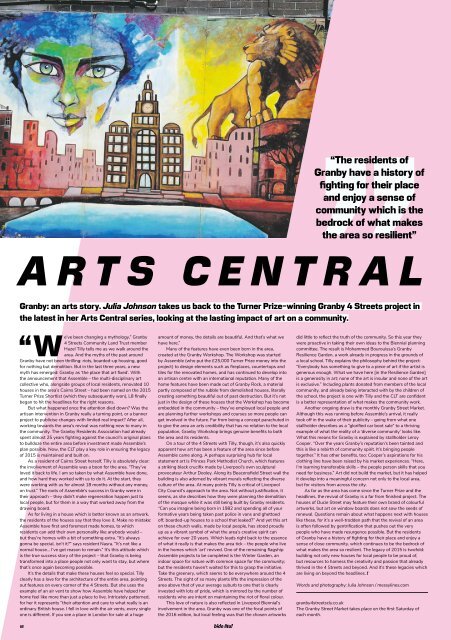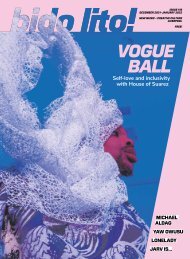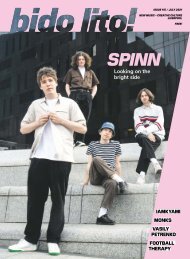Issue 89 / June 2018
June 2018 issue of Bido Lito! magazine. Featuring: ART OF FOOTBALL, BEACH SKULLS, BONNACONS OF DOOM, LAAF and POSITIVE VIBRATION, ALEX CAMERON, TRACKY, SOUND CITY 2018 REVIEW and much more.
June 2018 issue of Bido Lito! magazine. Featuring: ART OF FOOTBALL, BEACH SKULLS, BONNACONS OF DOOM, LAAF and POSITIVE VIBRATION, ALEX CAMERON, TRACKY, SOUND CITY 2018 REVIEW and much more.
Create successful ePaper yourself
Turn your PDF publications into a flip-book with our unique Google optimized e-Paper software.
“The residents of<br />
Granby have a history of<br />
fighting for their place<br />
and enjoy a sense of<br />
community which is the<br />
bedrock of what makes<br />
the area so resilient”<br />
ARTS CENTRAL<br />
Granby: an arts story. Julia Johnson takes us back to the Turner Prize-winning Granby 4 Streets project in<br />
the latest in her Arts Central series, looking at the lasting impact of art on a community.<br />
been changing a mythology,” Granby<br />
4 Streets Community Land Trust member<br />
Hazel Tilly tells me as we walk around the<br />
“We’ve<br />
area. And the myths of the past around<br />
Granby have not been thrilling: riots, boarded-up housing, good<br />
for nothing but demolition. But in the last three years, a new<br />
myth has emerged: Granby as ‘the place that art fixed’. With<br />
the announcement that Assemble – the multi-disciplinary art<br />
collective who, alongside groups of local residents, renovated 10<br />
houses in the area’s Cairns Street – had been named on the 2015<br />
Turner Prize Shortlist (which they subsequently won), L8 finally<br />
began to hit the headlines for the right reasons.<br />
But what happened once the attention died down? Was the<br />
artisan intervention in Granby really a turning point, or a banner<br />
project to publicise changes with limited real impact? After all,<br />
working towards the area’s revival was nothing new to many in<br />
the community. The Granby Residents Association had already<br />
spent almost 25 years fighting against the council’s original plans<br />
to bulldoze the entire area before investment made Assemble’s<br />
plan possible. Now, the CLT play a key role in ensuring the legacy<br />
of 2015 is maintained and built on.<br />
As a resident of Cairns Street herself, Tilly is absolutely clear:<br />
the involvement of Assemble was a boon for the area. “They’ve<br />
loved it back to life. I am so taken by what Assemble have done,<br />
and how hard they worked with us to do it. At the start, they<br />
were working with us for almost 18 months without any money,<br />
on trust.” The roots of Assemble’s success in Granby were in<br />
their approach – they didn’t make regeneration happen just to<br />
local people, but for them in a way that worked away from the<br />
drawing board.<br />
As for living in a house which is better known as an artwork,<br />
the residents of the houses say that they love it. Make no mistake:<br />
Assemble have first and foremost made homes, to which<br />
residents can add their own personality like anybody would –<br />
but they’re homes with a bit of something extra. “It’s always<br />
gonna be special, isn’t it?” says resident Nasra. “It’s not like a<br />
normal house… I’ve got reason to remain.” It’s this attitude which<br />
is the true success story of the project – that Granby is being<br />
transformed into a place people not only want to stay, but where<br />
that’s once again becoming possible.<br />
It’s the details that make these houses feel so special. Tilly<br />
clearly has a love for the architecture of the entire area, pointing<br />
out features on every corner of the 4 Streets. But she uses the<br />
example of an air vent to show how Assemble have helped her<br />
home feel like more than just a place to live. Intricately patterned,<br />
for her it represents “their attention and care to what really is an<br />
ordinary British house. I fell in love with the air vents, every single<br />
one is different. If you see a place in London for sale at a huge<br />
amount of money, the details are beautiful. And that’s what we<br />
have here.”<br />
Many of the features have even been born in the area,<br />
created at the Granby Workshop. The Workshop was started<br />
by Assemble (who put the £25,000 Turner Prize money into the<br />
project) to design elements such as fireplaces, countertops and<br />
tiles for the renovated homes, and has continued to develop into<br />
an artisan centre with an international reputation. Many of the<br />
home features have been made out of Granby Rock, a material<br />
partly composed of the rubble from demolished houses, literally<br />
creating something beautiful out of past destruction. But it’s not<br />
just in the design of these houses that the Workshop has become<br />
embedded in the community – they’ve employed local people and<br />
are planning further workshops and courses so more people can<br />
get involved in the future. Far from being a concept parachuted in<br />
to give the area an arts credibility that has no relation to the local<br />
population, Granby Workshop brings genuine benefits to both<br />
the area and its residents.<br />
On a tour of the 4 Streets with Tilly, though, it’s also quickly<br />
apparent how art has been a feature of the area since before<br />
Assemble came along. A perhaps surprising hub for local<br />
statement art is Princes Park Methodist Church, which features<br />
a striking black crucifix made by Liverpool’s own sculptural<br />
provocateur Arthur Dooley. Along its Beaconsfield Street wall the<br />
building is also adorned by vibrant murals reflecting the diverse<br />
culture of the area. At many points Tilly is critical of Liverpool<br />
City Council’s approach to the area. Not without justification, it<br />
seems, as she describes how they were planning the demolition<br />
of the mosque while it was still being built by Granby residents.<br />
“Can you imagine being born in 1982 and spending all of your<br />
formative years being taken past police in vans and ghettoed<br />
off, boarded-up houses to a school that leaked?” And yet this art<br />
on these church walls, made by local people, has stood proudly<br />
up as a vibrant symbol of what the area’s creative spirit can<br />
achieve for over 20 years. Which leads right back to the essence<br />
of what it really is that makes the area tick – the people who live<br />
in the homes which ‘art’ revived. One of the remaining flagship<br />
Assemble projects to be completed is the Winter Garden, an<br />
indoor space for nature with common space for the community;<br />
but the residents haven’t waited for this to grasp the initiative.<br />
Take the greenery, which seems to be everywhere around the 4<br />
Streets. The sight of so many plants lifts the impression of the<br />
area above that of your average suburb to one that is clearly<br />
invested with lots of pride, which is mirrored by the number of<br />
residents who are intent on maintaining the riot of floral colour.<br />
This love of nature is also reflected in Liverpool Biennial’s<br />
involvement in the area. Granby was one of the focal points of<br />
the 2016 edition, but local feeling was that the chosen artworks<br />
did little to reflect the truth of the community. So this year they<br />
were proactive in taking their own ideas to the Biennial planning<br />
committee. The result is Mohammed Bourouissa’s Granby<br />
Resilience Garden, a work already in progress in the grounds of<br />
a local school. Tilly explains the philosophy behind the project:<br />
“Everybody has something to give to a piece of art if the artist is<br />
generous enough. What we have here [in the Resilience Garden]<br />
is a generosity in art; none of the art is insular and none of the art<br />
is exclusive.” Including plants donated from members of the local<br />
community, and already being interacted with by the children of<br />
the school, the project is one with Tilly and the CLT are confident<br />
is a better representation of what makes the community work.<br />
Another ongoing draw is the monthly Granby Street Market.<br />
Although this was running before Assemble’s arrival, it really<br />
took off in the wake of their publicity – going from what one<br />
stallholder describes as a “glorified car boot sale” to a thriving<br />
example of what the reality of a ‘diverse community’ looks like.<br />
What this means for Granby is explained by stallholder Leroy<br />
Cooper. “Over the years Granby’s reputation’s been tainted and<br />
this is like a rebirth of community spirit. It’s bringing people<br />
together.” It has other benefits, too: Cooper’s aspirations for his<br />
clothing line have been raised by his market experiences. “Here,<br />
I’m learning transferable skills – the people person skills that you<br />
need for business.” Art did not build the market, but it has helped<br />
it develop into a meaningful concern not only to the local area,<br />
but for visitors from across the city.<br />
As far as the area has come since the Turner Prize and the<br />
headlines, the revival of Granby is a far from finished project. The<br />
houses of Ducie Street may feature their own brand of colourful<br />
artworks, but art on window boards does not sow the seeds of<br />
renewal. Questions remain about what happens next with houses<br />
like these, for it’s a well-trodden path that the revival of an area<br />
is often followed by gentrification that pushes out the very<br />
people who have made resurgence possible. But the residents<br />
of Granby have a history of fighting for their place and enjoy a<br />
sense of close community, which continues to be the bedrock of<br />
what makes the area so resilient. The legacy of 2015 is twofold:<br />
building not only new houses for local people to be proud of,<br />
but resources to harness the creativity and passion that already<br />
thrived in the 4 Streets and beyond. And it’s these legacies which<br />
are living on beyond the headlines. !<br />
Words and photography: Julia Johnson / messylines.com<br />
granby4streetscly.co.uk<br />
The Granby Street Market takes place on the first Saturday of<br />
each month.<br />
16


















